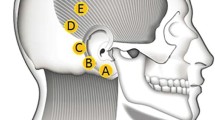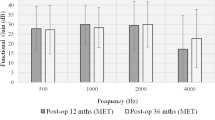Abstract
Aim
The fully implantable middle ear implant (C-FI-MEI) is designed for patients with moderate-to-severe sensorineural hearing loss or those with mixed hearing loss. To analyze the audiological post-operative results of subjects bilaterally implanted with C-FI-MEI.
Materials and methods
Retrospective study: 14 patients with bilateral, moderate-to-severe, sensorineural or mixed hearing loss were treated. This clinical sample included 14 cases bilaterally implanted (13 sequentially, 1 simultaneously). The evaluation at each follow-up after surgery included otologic examination, a structured interview, and different audiological tests composed of pure tone audiometry, speech in quiet and in noise test, and localization task. The mean follow-up was 67.2 ± 33 months.
Results
There were no significant differences between pre and post-operative pure tone averages. The patients showed no significant differences between pre-operatively aided and C-FI-MEI implant-aided conditions in terms of word recognition score. Speech perception in noise under different loudspeaker arrangements and localization tests demonstrated a binaural advantage in bilaterally implanted patients. The mean daily use time was 17.4 and 16.7 h, respectively, for right and left side.
Conclusion
The results for the 14 patients, bilaterally implanted with C-FI-MEI, suggest that bilateral implantation of fully implantable middle ear hearing devices is an effective procedure.
Level of evidence
4.





Similar content being viewed by others
References
Klein K, Nardelli A, Stafinski T (2012) A systematic review of the safety and effectiveness of fully implantable middle ear hearing devices: the carina and esteem systems. Otol Neurotol 33(6):916–921
Pulcherio JOB, Bittencourt AG, Burke PR, Monsanto RC, de Brito R, Tsuji RK, Bento RF (2014) Carina© and Esteem©: a systematic review of fully implantable hearing devices. PLoS ONE 9(10):e110636
Seidman MD, Janz TA, Shohet JA (2019) Totally implantable active middle ear implants. Otolaryngol Clin N Am 52:297–309
Debeaupte M, Decullier E, Tringali S, Devèze A, Mom T, Darrouzet V, Truy E (2015) Evolution of the reliability of the fully implantable middle ear transducer over successive generations. Otol Neurotol 36:625–630
Uhler K, Anderson MC, Jenkins HA (2016) Long-term outcome data in patients following new year’s use of a fully implantable active middle ear implant. Audiol Neurotol 21:105–112
Devèze A, Rameh C, Sanjuan M, Lavieille JP, Magnan J (2010) A middle ear implant with a titanium canal wall prosthesis for a case of an open mastoid cavity. Auris Nasus Larynx 37:631–635
Bruschini L, Berrettini S, Forli F, Murri A, Cuda D (2016) The Carina© middle ear implant: surgical and functional outcomes. Eur Arch Otorhinolaryngol 273:3631–3640
Lefebvre PP, Gisbert J, Cuda D, Tringali S, Devèze A (2016) A retrospective multicentre cohort review of patient characteristics and surgical aspects versus the long-term outcomes for recipients of a fully implantable active middle ear implant. Audiol Neurotol 21:333–345
Turrini M, Cutugno F, Maturi P, Prosser S, Leoni FA (1993) Arslan E Bisyllabic words for speech audiometry: a new Italian material. Acta Otorhinolaryngol Ital 13(1):63–77
Puglisi GE, Warzybok A, Hochmuth S, Visentin C, Astolfi A, Prodi N, Kollmeier B (2015) An Italian matrix sentence test for the evaluation of speech intelligibility in noise. Int J Audiol 54(Suppl 2):44–50
Kam AC, Sung JK, Yu JK et al (2012) Clinical evaluation of a fully implantable hearing device in six patients with mixed and sensorineural hearing loss: our experience. Clin Otolaryngol 37(3):240–244
Uhler K, Anderson MC, Jenkins HA (2016) Long-term outcome data in patients following one year’s use of a fully implantable active middle ear implant. Audiol Neurotol 21:105–112
Wolf-Magele A, Koci V, Schnabl J, Zorowka P, Riechelmann H, Sprinzl GM (2016) Bilateral use of active middle ear implants: speech discrimination results in noise. Eur Arch Otorhinolaryngol 273(8):2065–2072
Koci V, Seebacher J, Weichbold V, Zorowka P, Wolf-Magele A, Sprinzl G, Stephan K (2016) Improvement of sound source localization abilities in patients bilaterally supplied with active middle ear implants. Acta Otolaryngol 136(7):692–698
Kraaijenga VJC, Ramakers GGJ, Smulders YE, van Zon A, Stegeman I, Smit AL, Stokroos RJ, Hendrice N, Free RH, Maat B, Frijns JHM, Briaire JJ, Mylanus EAM, Huinck WJ, Van Zanten GA, Grolman W (2017) Objective and subjective measures of simultaneous vs sequential bilateral cochlear implants in adults: a randomized clinical trial. JAMA Otolaryngol Head Neck Surg 143(9):881–890
Coordes A, Jahreiss L, Schönfeld U, Lenarz M (2017) Active middle ear implant coupled bilaterally to the round window despite bilateral implanted stapes prostheses. Laryngoscope 127(2):500–503
Lachowska M, Niemczyk K, Yazbeck A, Morawski K, Bruzgielewicz A (2012) First bilateral simultaneous implantation with fully implantable middle ear. Hearing device. Arch Med Sci 8:736–742
Van den Bogaert T, Klasen T, Moonen M, Van Deun L, Wouters J (2006) Horizontal localization with bilateral hearing aids: without is better than with. J Acoust Soc Am 119:515–526
Walden TC, Walden BE (2005) Unilateral versus bilateral amplification for adults with impaired hearing. J Am Acad Audiol 16(8):574–584
Gifford RH, Grantham DW, Sheffield SW, Davis TJ, Dwyer R, Dorman MF (2014) Localization and interaural time difference (ITD) thresholds for cochlear implant recipients with preserved acoustic hearing in the implanted ear. Hear Res 312:28–37
Keidser G, Rohrseitz K, Dillon H, Hamacher V, Carter L, Rass U, Convery E (2006) The effect of multi-channel wide dynamic range compression, noise reduction, and the directional microphone on horizontal localization performance in hearing aid wearers. Int J Audiol 45(10):563–579
Picou EM, Aspell E, Ricketts TA (2014) Potential benefits and limitations of three types of directional processing in hearing aids. Ear Hear 35(3):339–352
Funding
None.
Author information
Authors and Affiliations
Corresponding author
Ethics declarations
Conflict of interest
The authors have no conflicts of interest to disclose.
Additional information
Publisher's Note
Springer Nature remains neutral with regard to jurisdictional claims in published maps and institutional affiliations.
Rights and permissions
About this article
Cite this article
Cuda, D., Murri, A., Mainardi, A. et al. Binaural hearing restoration with a bilateral fully implantable middle ear implant. Eur Arch Otorhinolaryngol 278, 2239–2246 (2021). https://doi.org/10.1007/s00405-020-06290-3
Received:
Accepted:
Published:
Issue Date:
DOI: https://doi.org/10.1007/s00405-020-06290-3




